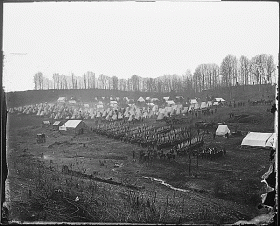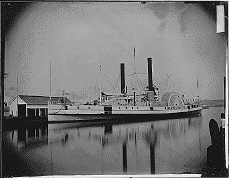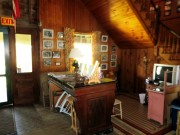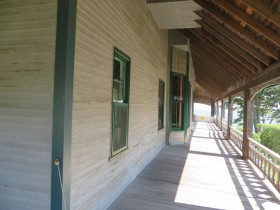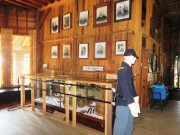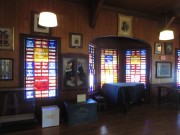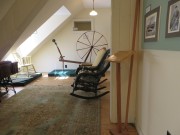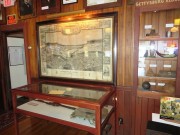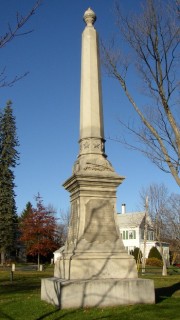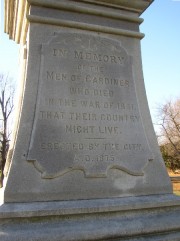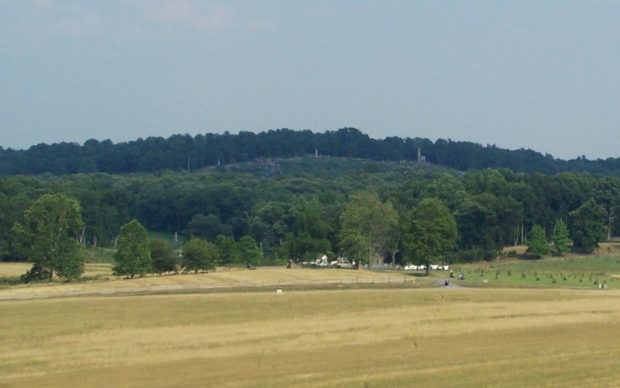
“It happened so unexpectedly, so abruptly, that she forgot to scream. . . . Breathless, spellbound, she moved on tiptoe to the porch, one hand pressed trembling across her lips. The field of oats shimmered a moment before her eyes, then a blue mass swung into it and it melted away, sheered to the earth in glimmering swaths as gilded grain falls at the sickle’s sparkle. An the men in blue covered the earth, the world, her world, which stretched from the orchard to Benson’s Hill.*
The American Civil War had a major impact on Maine, whose armed forces played a leading role in Maine’s participation in the Civil War. The Adjutant General’s Office in Maine State government had extensive records of Maine’s participation in the Civil War. Now in the Maine State Archives, they are a treasure for re-enactors, authors, and family history researchers.
During the war 72,945 Maine people served in the military, 7,322 of whom were killed and 67 of whom received the Congressional Medal of Honor. Several went on to become governors of the state (Henry Cleaves, Seldon Connor, Daniel F. Davis, Harris Plaisted, Frederick Robie, ), the most famous one being Joshua Chamberlain.
The state’s shipping industry was hard hit by the loss of trade with southern ports and by the loss of vessels captured by Confederate raiders. Within a few weeks of the fall of Fort Sumpter on April 13, 1861, northern commercial ships were subject to attack. Eighty-eight were sunk, burned, confiscated, released, or otherwise disposed of from May 12, 1861 to December 29, 1864. (Search “Confederate raiders” for vessels and dates of capture.)
One such event began near Haskell Island in Harpswell when the Confederate privateer Archer forced local fishermen to guide them into Portland Harbor. There, on June 29, 1863, they commandeered the revenue cutter Caleb Cushing and attempted to escape with it. But, realizing they would soon be captured, they blew up the cutter and were then taken into custody.
Maine units fought in many critical battles of the war. At left is an encampment of the 2nd Maine Infantry. A company of infantry were part of the 6th Maine Infantry after the battle of Fredericksburg at the time of the charge across the stone wall at the foot of Marye Heights. General Hooker was in command of Federals; General Fitzhugh Lee, in command of Confederates.
The Battle of Gettysburg is among the most notable, with future Maine governor Joshua L. Chamberlain leading the 20th Maine Regiment holding Little Round Top for the Union forces.
The transport steamer State of Maine (not to be confused with the U.S.S. Maine) moved Union troops during the war. As part of General George B. McClellan’s Union Army of the Potomac’s massive, but ill-fated, attack in the spring of 1862, the vessel carried troops from Alexandria to Fortress Monroe in Virginia, where many ships, including the now famous Monitor, had gathered.
The photo above was taken by Matthew Brady’s company. The National Archives’ notes on his photo collection observes,
With the outbreak of the Civil War in 1861, Brady endeavored to record the progress of the war with his camera. He and his associates, notably Alexander Gardner, George Barnard, and Timothy O’Sullivan, traveled throughout the eastern part of the country and photographed many of the battlefields, towns, and people touched by the war. In addition, Brady photographed many of the distinguished political and military personalities who found time to stop by his Washington, DC studio. The result was a collection of some 12,000 images (possibly more) which comprises a rich visual document of the Civil War period.
Maine women were also involved, such as Ellen Gould Harmon White, who encouraged people to assist escaped slaves in the underground railroad; Dorothea Dix, who advocated for the wounded on the battlefields; and Sarah Simpson, who visited the wounded and helped bring food and medicine to the Union troops.
Gideon Palmer of Gardiner volunteered as a surgeon to the wounded. He later was promoted to head several hospitals for veterans.
After the war, many men went West to seek their fortunes, rather than return to Maine, causing a major labor force problem for the state. As a result, political leaders encouraged immigration to fill the void, with the Swedish Colony being one of the great success stories.
Those veterans who returned to Maine savored the friendships of those with whom they had shared terrible difficulties during the long, bloody, literally sickening conflict. As the photo at right suggests, one consolation was that they had accomplished an important goal: the end of slavery. Frederick Douglass, a former slave, an articulate spokesman for the anti-slavery cause, and a journalist, helped recruit black me for the Union Army. He attended the 1877 reunion of the First Maine Cavalry. (The white haired gentleman next to the girl in a white dress.)
The Fifth and Eighth Maine Regiments have historical museums devoted to each on Peaks Island in Casco Bay.
Almost every town organized by 1865 has its Civil War memorial, often a tall monument, such as that in the Gardiner Common park, erected in 1875. For other reference to this conflict enter “civil war” (with quotes) in the search box above right.
Additional resources
Bennett, Wayne E. Abbot Maine Civil War Sailor Allen Woods Remembered: The Long Search for a Forgotten Son of the State of Maine. Abbot, Me. Abbot Historical Society. 2008.
*Chambers, Robert W. The Haunts of Men. New York. Frederick A. Stokes Company. Second Edition. 1898.
Flaherty, Paul Arthur. The Effect of the Civil War upon Portland, Maine. 1966.
Ledman, Paul J. A Maine Town Responds: Cape Elizabeth & South Portland in the Civil War. Cape Elizabeth, Me. Next Steps Publishing. 2003.
McCormick, Donald Munroe. A Cross-section of Maine History During the Civil War Period. 1934.
Portland Soldiers and Sailors: A Brief Sketch of the Part They Took in the War of the Rebellion. Portland, Me. Bosworth Post, Grand Army of the Republic. 1884. (Portland. B. Thurston & Co.)
Pullen, John J. The Twentieth Maine: A Volunteer Regiment in the Civil War. Dayton, Ohio: Press of Morningside Bookshop. 1984.
Roberts, Gwilym R. Sebec, Maine: Before, During, and After the Civil War. Farmington, Me. University of Maine Farmington. Printing Department. 1991.
Thompson, Kenneth E. Civil War Maine Hall of Fame: Political Judicial, and Military Leaders, 1861-1865. Portland, Me. The Thompson Group. c2000.
United States. Census Office. 11th census, 1890. Schedules Enumerating Union Veterans and Widows of Union Veterans of the Civil War: Maine. [microform]. Washington. National Archives, 1948. (available at University of Maine Farmington library and Bangor Public Library)
Maine State Archives. “Civil War. ” Augusta, Me. http://www.maine.gov/sos/arc/research/civilwar2/ Resources for researchers and teachers. (accessed October 20, 2011)
This are only a small sample of the resources found at http://ursus.maine.edu/, KEYWORDS: civil war Maine
Photo credits:
Camp scene, 2nd Maine Infantry, Matthew Brady photo from the National Archives # NWDNS-111-B-487A
Part of 6th Maine Infantry after the Battle of Fredericksburg. National Archives # NWDNS-111-B-168
Steamer State of Maine. National Archives # NWDNS-111-B-5191. Photo by Matthew Brady’s company.


